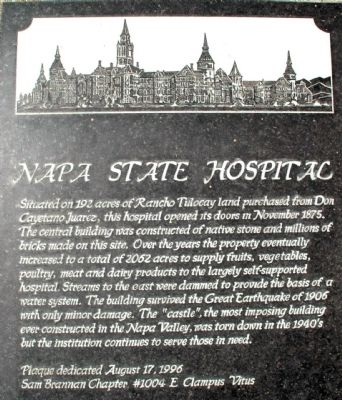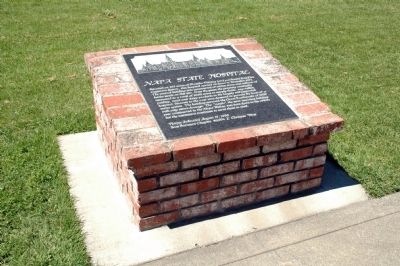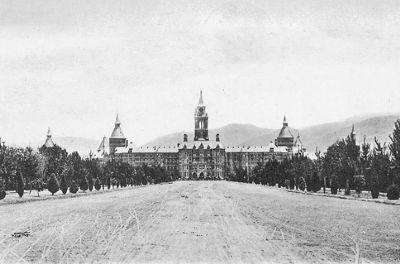Napa in Napa County, California — The American West (Pacific Coastal)
Napa State Hospital
Erected 1996 by Sam Brannan Chapter #1004 E Clampus Vitus.
Topics and series. This historical marker is listed in this topic list: Science & Medicine. In addition, it is included in the E Clampus Vitus series list. A significant historical month for this entry is November 1875.
Location. 38° 16.684′ N, 122° 16.085′ W. Marker is in Napa, California, in Napa County. Marker is at the intersection of Magnolia Drive and North Oak Drive on Magnolia Drive. Plaque is mounted on a brick monument in front of the Administration Building at Napa State Hospital at the intersection of Magnolia Drive and Oak Drive on the hospital grounds. Touch for map. Marker is at or near this postal address: 2100 Napa Valley Highway, Napa CA 94558, United States of America. Touch for directions.
Other nearby markers. At least 8 other markers are within 2 miles of this marker, measured as the crow flies. Dave Cavagnaro Circus Plaza (approx. 1.4 miles away); Embarcadero de Napa (approx. 1.4 miles away); Holden Mansion 1886 (approx. 1.4 miles away); Napa: A River Landing Town (approx. 1˝ miles away); Banner Warehouse 1862 (approx. 1˝ miles away); Hatt Building 1893 (approx. 1˝ miles away); Hay Barn 1959 (approx. 1˝ miles away); Silo Building 1932 (approx. 1˝ miles away). Touch for a list and map of all markers in Napa.
Additional commentary.
1. Additional Information Regarding the Marker Dedication
Bob Cato was Noble Grand Humbug when this plaque was dedicated. Plaque wording By Loren A. Wilson.
— Submitted April 18, 2012, by Loren Wilson of Sebastopol, California.
2. Napa State Hospital
The first state hospital for the mentally ill was constructed in Stockton in 1852. It was built to accommodate 80 people and by the late 1860s, had become impossibly overcrowded. In 1870 the California State Legislature passed a bill to establish a second hospital. Governor H. H. Haight commissioned Dr. Edmund T. Wilkins to conduct a study of other institutions in order to arrive at the most effective design and plan for the care and treatment of the mentally ill. Dr. Wilkins, a native of Tennessee, had immigrated to California in 1852; he moved to Marysville in 1861.
Dr. Wilkins took his assignment seriously. He visited 149 asylums on two continents, including 45 in the U.S., 11 in what was then the German states, 13 in France, 10 in Scotland, and two in Switzerland. He presented an exhaustive report favoring the "moral treatment" of the mentally ill and presented it to the Governor on December 2, 1871. Then Governor Booth appointed three commissioners, among them Dr. Wilkins, to select a site for the new hospital.
Napa was selected as the site due to its healthful and stable climate, the availability of good land at reasonable prices, and its proximity to a waterway for receiving supplies. Three Napa pioneers (banker James Goodman, lawyer Chancellor Hartson, and businessman Robert Sterling) were appointed to administer the funds to build a 500-bed hospital.
The board initially purchased 192 acres from Don Cayatano Juarez, gradually adding land until the total acreage reached 2000. The holdings included a wharf on the Napa River, a siding at the Southern Pacific tracks, vegetable fields, a duck ranch, and the Skyline Park area. An outlying ranch provided the hospital's water and cattle was raised on the hospital's farm just northeast of Yountville.
The architectural contract for the hospital building was awarded to the San Francisco firm of Wright and Sanders. Ground was broken in October 1872; actual construction began February 11, 1873. The brick and stone used in the construction of the hospital were quarried on the grounds.
The seven-towered domestic Gothic structure was elaborate and ornate and it quickly became one of Napa's first tourist attractions. "The Castle," as it came to be called, faced the west with wings extending on either side, allowing for plenty of fresh air to flow throughout the facility. There was an underground cog railroad used to carry meals and laundry to the wings.
The first patients were admitted November 15, 1875. Many of the patients were displaced persons or those who suffered from alcoholism or drug addiction. By 1880 the patient load had increased to such an extent that funds were appropriated to finish the attic areas to accommodate more residents.
The facility soon became self-sufficient. On March 16, 1876, Dr. Wilkins became resident physician, succeeding Dr. Edward Bentley. In 1922 the Department of Institutions was established, changing views of mental illness. "Insanity" became recognized as mental illness. Additionally, the Castle became outdated. Although the Castle had survived the 1906 earthquake, it was razed in 1949. However, it did not go gently; it ultimately had to be dynamited. Today Napa State Hospital serves 100-300 patients/residents through the use of 14 small management teams.
Rich Benyo, NGH #28
— Submitted April 18, 2012, by Loren Wilson of Sebastopol, California.
Credits. This page was last revised on June 16, 2016. It was originally submitted on April 18, 2012, by Loren Wilson of Sebastopol, California. This page has been viewed 1,609 times since then and 53 times this year. Photos: 1, 2. submitted on April 18, 2012, by Loren Wilson of Sebastopol, California. 3. submitted on May 3, 2012. • Syd Whittle was the editor who published this page.


